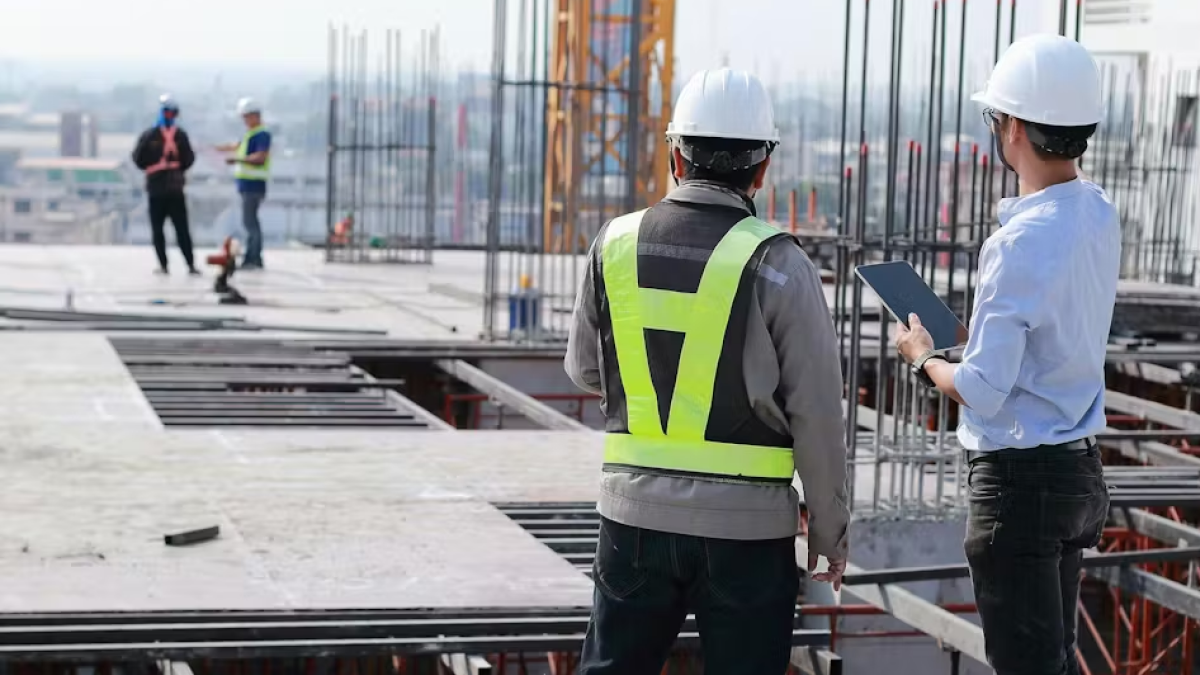
The BD+C editorial team asked the 2024 Contractor Giants to submit their single-biggest firm innovation for the past 12 months. Here’s a roundup of the most-compelling innovations.
More than 200 (202 to be exact) building-sector contractors and construction managers participated in BD+C’s 2024 Giants 400 survey. Roughly half (106) submitted their “single-biggest firm innovation” for the past 12 months. Here’s a roundup of the most-compelling innovations from the 2024 Contractor Giants (in alpha order):
Alston Construction introduced an automation business unit, AIM, dedicated to managing the installation of warehouse and supply chain automation robotics in distribution facilities. The company also launched a dedicated cold storage project team.
Andres Construction Services implemented ProVizual, a custom tool developed to support the firm’s QA/QC process. It allows team members to visually see quality control progress on drawings.
Austin Industries’ AustinEDGE converts drone flights into photorealistic models for site logistics planning sessions. The model exported from drone capture is stripped of its colors. Then, the firm reapplies the color by processing it through 3DS Max. “This saves us a lot of time because we no longer need to physically model the area surrounding our project sites,” says the firm.
Balfour Beatty US is using the latest AR/VR tools like Apple Vision Pro and Meta Quest 3 to help clients secure project financing and accelerate a project’s time to profitability upon completion. The firm cites recent luxury apartment and condominium projects, where sophisticated, immersive virtual walkthroughs helped clients interact with not only a building’s interior, but also approximate views from exterior-facing windows. “Rather than basing financing proposals and tenant recruitment on hypothetical views and imagined spaces, [we] help clients attract business with virtual, experiential knowledge of the space,” says the firm.
Coastal Construction Group helped launch RENCO USA in 2023. The startup’s building system uses LEGO-like interlocking molded blocks to build high-strength, affordable buildings in rapid fashion. Made with repurposed glass fibers, resin, and stone, this renewable composite material is certified to withstand Category 5 hurricanes. In November, Coastal finished the first RENCO project in America, an apartment complex in South Florida, which required only 11 unskilled labor workers to build.
DPR Construction piloted several robot solutions in 2023, including Vita Inclinata’s load stabilizer, which eliminates the need for taglines and risks associated with them. “We also were able to demobilize a tower crane using Vita’s product, and it’s incredible to see the boom of a tower crane taken apart on the ground rather than at height,” says the firm. DPR also tested Raise Robotics’ robotic platform, which aids workers by tackling the repetitive, highly dexterous tasks on jobsites.
Findorff Construction’s new Embodied Carbon Reduction Analysis Initiative influences every phase of the construction process, from design to material procurement, emphasizing the selection of low-carbon alternatives to meet both environmental goals and project requirements.
Fortis Construction’s visual design and construction team developed VR walkthroughs of BIM models, both for internal teams and clients. During the construction of a new data center in Singapore, Fortis employed Resolve—an Autodesk VR integration tool—alongside Meta Quest VR headsets. This strategic combination allowed the team to avoid $3 million worth of rework within a three-month span.
Gilbane launched a dedicated in-house supply chain management team, which oversees the company-wide supply chain and its supplier relationship management (SRM) platform. The team leverages the construction giant’s global economies of scale for the sourcing of building systems and equipment with an eye toward efficiency, quality, brand assurance, and sustainability.
Harkins Builders’ Innovative Capital Reinvestment Program encourages the firm’s employee-owners to become creative problem-solvers by providing funding for innovation projects. “The program’s success is undeniable. It has already championed nine transformative projects, each tackling unique challenges and complexities, ultimately saving resources or driving new revenue streams,” says the firm.
Haskell’s venture capital arm, Dysruptek, continues to launch, develop, and support ConTech innovations. Its latest development, Steel Harmony, is a plugin for Autodesk’s Revit platform that catalogs unallocated steel in the Haskell Steel (the company’s steel fabrication operation) inventory and matches applicable members with designers’ plans, saving time and money. Dysruptek also formed a partnership with Hyperframe, a metal framework kit that can be snapped together in minutes. Hyperframe begins building the framework using its proprietary web-based application called HyperBIM. After loading the structure’s design into the application, it extracts the wall components and automatically runs a clash detection. It then highlights any conflicts and optimizes the model. Its installation process uses AR headsets to give real-time instructions on where each piece needs to be snapped into place.
Hill International implemented the use of data analytics, automated workflows, and purpose-built dashboards on large projects and programs. Benefits include real-time performance measurement, identifying bottlenecks, and evaluating key performance indicators (KPIs). The results have been so positive that the firm is exploring ways to offer its data analytics capabilities as a stand-alone service.
HITT Contracting’s dedicated R&D team, Co|Lab, investigated more than 20 projects with 25 partners in 2023, including one of the first 3D printing uses of Caracol’s Heron AM robotic arm in the U.S. The team also pioneered ECOPact, a low-carbon concrete mix, alongside Holcim and Baker Concrete, on a data center in Virginia. ECOPact emits 35-45% less carbon than standard concrete, says the firm.
Lease Crutcher Lewis is aiming to be the first regional contractor to commit to reducing embodied carbon from its established baseline by 5% for the concrete placed on all its projects this year. “We’ve met with major local concrete suppliers and structural engineering partners to discuss opportunities to use lower-carbon mixes that minimize the amount of cement with little-to-no increased costs,” says the firm.
To enhance its solar construction business, McCarthy Building Companies deployed two OnSight Technology inspection robots on its Double Black Diamond solar site in Sangamon County, Ill. The robots are designed to enhance project efficiency, safety, and accuracy by performing quality control checks, collecting data, and generating reports. Based on the project’s success, McCarthy is planning larger-scale deployments of OnSight robots this year.
With the goal of improving the working conditions for construction professionals on its jobsites, Mortenson launched its Future Field Office (F2O) initiative. The program’s first project, the F2O Plan-of-Day (POD), was deployed in June. The two-unit modular, 24×28-foot office features improved workspaces, lighting, acoustics, flooring, HVAC, furniture, and technology compared with traditional jobsite trailers, and it ships to projects as a complete package. Green features include high-R-value continuous exterior insulation and an energy recovery ventilator (ERV) system.
MYCON General Contractors expanded into the multifamily construction market, led by sector veteran and VP Tad Sellman. In addition, MYCON is integrating tech tools to streamline internal processes and improve training, including robotic process automation, which automates routine tasks to enhance efficiency, particularly in accounting, and machine learning and data analytics.
PCL Construction Enterprises implemented the LinkedIn Learning online education platform to the entire enterprise to help employees grow their knowledge base and stay current on in-demand skills.
Pepper Construction’s new Jobsite Information Hub, which is accessible to its tradespeople via their mobile devices, helps to communicate safety protocols, optimize workflow, and improve overall communication on jobsites. “Traditionally, jobsite information has been shared with printouts, signage, and other non-digital media that have been challenging to keep current,” says the firm.
Poettker Construction launched its NextGen Initiative, where the company collaborates with school districts to incorporate real-time construction learning into each grade-level curriculum. Through NextGen, students join in the celebration of major project milestones, from groundbreaking and dedication ceremonies to on-site class tours. Poettker also offers hands-on career success opportunities through STEAM learning, paid internships, and workforce development programs.
Premier launched an Adaptive Reuse practice, aimed at helping clients with office and commercial building conversions.
Richard Group implemented open-book management to improve organizational performance. The strategy involves sharing company financial information with every employee, as well as providing financial literacy education. “By demystifying company financials and clarifying revenue streams, expenses, and profit margins, we’re empowering employees at all levels to grasp how their daily tasks affect the bottom line,” says the firm.
Robins & Morton launched its internal Innovation Awards, which attracted entries from more than 200 team members. Among the three winners is a multi-camera retrofit system for older heavy equipment. It reduces incidence rates by enhancing visibility and minimizing the dangers of blind spots.
Rogers-O’Brien Construction introduced VigiLife’s SafeGuard to jobsites. The health and safety platform, which marries advanced analytics with environmental and biometric data (via noninvasive wearables), is designed to “outsmart” heat-related risks on construction sites by monitoring and predicting potential health threats in real time. The result? Zero heat-related injuries at RO sites in 2023.
Satterfield & Pontikes Construction created an operations support department, Project Success Planning (PSP), to enhance project operational consistency and efficiency. The group helps project teams quickly startup and takes on tasks that do not have to happen in the field “so projects start strong and end strong,” says the firm.
Saunders Construction established a company-wide mental health initiative. The firm also developed its Go Happy Texting program to better communicate with all employees, including field team members. All communications are translated into Spanish.
Shawmut Design and Construction launched its Mental Health & Wellness Leadership Group in 2023. The group includes more than 50 people—across functions and roles—dedicated to identifying programs, initiatives, and paths to address the mental health crisis in the industry. Among its first initiatives are Culture of Care Conversations (safe-space conversations specifically for field team members) and MHWLG workstreams (external and internal workstreams to focus on developing mental health initiatives for jobsites, offices, industry, and communities).
Skanska USA, last year, became one of the first contractors to develop and launch its own secure generative AI tool. Called Skanska Sidekick, the program provides a chatbot interface with a dynamic feature: uploading and querying internal work documents. A few use cases include reviewing and editing content, summarizing information, and refining talking points.
Skyler Design Build implemented two innovative strategies over the past year: a dedicated labor force that travels nationwide for healthcare projects, and the implementation of expedited natural disaster response reconstruction and restoration services. “These innovations have resulted in significant cost savings for clients, expedited construction timelines, and minimized losses for insurance and healthcare facilities,” says the firm.
Tester Construction Group launched TCGreen, an initiative to reduce environmental impact on projects, while also improving the quality of buildings for end users. Focal points of TCGreen include the installation of green roofs, analysis and implementation of renewable energy, reduction and handling of material waste on project sites, and energy efficiency.
W. M. Jordan Company launched a Lean Construction Services department to promote a culture of continuous improvement by applying Lean techniques and strategies across all aspects of the company, and its projects.
The Weitz Company & Affiliates’ VDC team implemented several advanced tech tools on projects, including mobile Lidar scanners, the NavVis multi-sensor scanning system, and Dusty Robotics’ Dusty FieldPrinter. The latter takes blueprints for the jobsite and accurately prints them on the floors and decks for construction layout—and “in a fraction of the time and with increased precision,” says the firm.
Wesbuilt Construction Managers develops complete BIM models of all—even very small—projects in the preconstruction and construction phases. This work is done through the firm’s proprietary visual design and construction (VDC) and BIM process, called COLLAB. The company 3D scans all potential project sites prior to developing bids, a process that to a large extent eliminates confusion and dimension discrepancies even before Wesbuilt wins a contract.
View the full article here.








